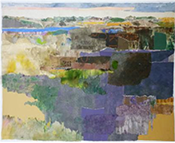“Most of all, I want to remember Anne the artist, the painter of extraordinary ‘inner landscapes’ (as she called them) on canvas, as well as her incredible pencil line drawings that—initially inspired by nature—led her to deeper meaning and introspection.
“This is a quote she made about her life’s work: ‘I fell in love with paint, the purity of the color, the texture, the pleasure of applying the paint to canvas until the final brushstroke.’
“Anne and Jennifer Cooke founded the Flea Market Beautification Committee because Anne couldn’t bear to see how chains tied to the Bethune Street trees by bike owners were destroying the bark and killing the trees. The proceeds from Flea Market sales went to fund the planter boxes on Bethune Street, which I designed and helped build. And that is how I got involved with the small committee of 2 + Al Cooke and Wesley Pollitt, Anne’s husband.
“Her other love besides creating art was with Wesley, her daughter Betsy, her small house in the country and the Flea Market. Along with Jennifer, Anne was kind, calm, and rational, a quietly determined, inspirational leader whom we trusted wholeheartedly. Her example of vision, harmony, and elegant wisdom, I hope can continue in the committee not only in honor and in celebration of her life and work, but most of all in gratitude for how she has touched our lives.”
-Christina Maile, excerpt from email to Beautification Committee, July 2023
 John Ahern
John Ahern
 Dongkuk (Don) Ahn
Dongkuk (Don) Ahn Cicely Aikman
Cicely Aikman Seth Allen
Seth Allen Benny Andrews
Benny Andrews Jeff Andrews
Jeff Andrews William Anthony
William Anthony Ruth Antonofsky
Ruth Antonofsky Diane Arbus
Diane Arbus Luis Avalos
Luis Avalos Helène Aylon
Helène Aylon Margalit Banai
Margalit Banai Allen Barber
Allen Barber George Barrow
George Barrow P.J. Barry
P.J. Barry Nadine Valenti Beauchamp
Nadine Valenti Beauchamp Robert Beauchamp
Robert Beauchamp Barton Benes
Barton Benes Paul Benjamin
Paul Benjamin Mirel Bercovici
Mirel Bercovici Susan Lynne Berger
Susan Lynne Berger Beryl Bernay
Beryl Bernay Karl Bissinger
Karl Bissinger Bonnie Bluh
Bonnie Bluh Jane Bolmeier
Jane Bolmeier Isabel Case Borgatta
Isabel Case Borgatta John Bottoms
John Bottoms Patti Bown
Patti Bown Anne Brody
Anne Brody Hiram Bullock
Hiram Bullock Claire Burch
Claire Burch Carole Byard
Carole Byard Olga Cabral
Olga Cabral Joseph Lawrence Cady
Joseph Lawrence Cady  Jacques Joseph Camins
Jacques Joseph Camins Anthony (Tony)
Anthony (Tony) Madlyn Cates
Madlyn Cates Nicolas Carone
Nicolas Carone Joseph Chaikin
Joseph Chaikin Miriam Chaikin
Miriam Chaikin Shami Chaikin
Shami Chaikin Ted Churchill
Ted Churchill Carol Cole
Carol Cole Malvine Cole
Malvine Cole Steve Conley
Steve Conley Jennifer Cooke
Jennifer Cooke Stanley Cowell
Stanley Cowell Bill Creston
Bill Creston Ronnie Cutrone
Ronnie Cutrone Carmen Czernik
Carmen Czernik Magda Dajani
Magda Dajani Najeeb (Geeby) Dajani
Najeeb (Geeby) Dajani Giglio Dante
Giglio Dante Nassos Daphnis
Nassos Daphnis George Deem
George Deem Katherine Hynes de Groot
Katherine Hynes de Groot Roy Andries de Groot
Roy Andries de Groot David Del Tredici
David Del Tredici Robert DeNiro, Sr
Robert DeNiro, Sr Jan Doubrava
Jan Doubrava John Dobbs
John Dobbs Jack Dowling
Jack Dowling Ree Dragonette
Ree Dragonette Sherman Drexler
Sherman Drexler Helen Duberstein
Helen Duberstein Ralph Dubin
Ralph Dubin George Dworzan
George Dworzan Hélène Dworzan
Hélène Dworzan Gil Evans
Gil Evans Ron Faber
Ron Faber Marsha Farley
Marsha Farley Fred Farr
Fred Farr Louis Faurer
Louis Faurer Mel Fowler
Mel Fowler Leonard Freed
Leonard Freed Theodore Fried
Theodore Fried Yoshishige Furukawa
Yoshishige Furukawa John Gamble
John Gamble Jean Garrigue
Jean Garrigue  Sonia Gechtoff
Sonia Gechtoff Vito Giacalone
Vito Giacalone Donald Goddard
Donald Goddard Kenneth Sean
Kenneth Sean Grant Gordon
Grant Gordon Arlene Gottfried
Arlene Gottfried Leslie Gourse
Leslie Gourse Sally Gross
Sally Gross Lee Guilliatt
Lee Guilliatt Moses Gunn
Moses Gunn Alex Haberstroh
Alex Haberstroh Patricia Hacker
Patricia Hacker Barbara Hammer
Barbara Hammer Peter Hanssen
Peter Hanssen Jon Hassell
Jon Hassell Theodore Haupt
Theodore Haupt Carol Hebald
Carol Hebald Ruth Herschberger
Ruth Herschberger Evelyn Hofer
Evelyn Hofer Beate Wheeler Holst
Beate Wheeler Holst Spencer Holst
Spencer Holst Patricia Horan
Patricia Horan Eleanor Hovda
Eleanor Hovda Richard Hundley
Richard Hundley Hugh Hurd
Hugh Hurd David Ignatow
David Ignatow Ralph Iwamoto
Ralph Iwamoto Robert Jensen
Robert Jensen Halvard Johnson
Halvard Johnson Cliff Joseph
Cliff Joseph Kathryn Kates
Kathryn Kates Allen Katzman
Allen Katzman Herbert Katzman
Herbert Katzman Minoru Kawabata
Minoru Kawabata James Kelly
James Kelly Risaburo Kimura
Risaburo Kimura Galway Kinnell
Galway Kinnell Harry Koursaros
Harry Koursaros Bea Kreloff
Bea Kreloff Morris Kriensky
Morris Kriensky Irving Kriesberg
Irving Kriesberg Shigeko Kubota
Shigeko Kubota Bettye Lane
Bettye Lane
 Jeanne Lee
Jeanne Lee Ralph Lee
Ralph Lee Freda Leinwand
Freda Leinwand Peter Lombard
Peter Lombard Ora Lerman
Ora Lerman Saul Lishinsky
Saul Lishinsky Robert Ludwig
Robert Ludwig John Manship
John Manship Margaret Cassidy Manship
Margaret Cassidy Manship Jack R. Marks
Jack R. Marks Ralph Martel
Ralph Martel Juanita McNeely
Juanita McNeely Nancy Meehan
Nancy Meehan Charles Meyers
Charles Meyers Laura Meyers
Laura Meyers Abigail McGrath
Abigail McGrath Tony McGrath
Tony McGrath Lennie Metcalfe
Lennie Metcalfe Gay Milius
Gay Milius Hal Miller
Hal Miller Jeanne Miles
Jeanne Miles Gerald Monroe
Gerald Monroe Bill Moor
Bill Moor Claire Moore
Claire Moore Hilda Morley
Hilda Morley Alice S. Morris
Alice S. Morris Gilbert Moses
Gilbert Moses Robert Munford
Robert Munford George Mukai
George Mukai Joe Muranyi
Joe Muranyi Elizabeth Murray
Elizabeth Murray Nantandy
Nantandy Madeleine Yayodele Nelson
Madeleine Yayodele Nelson Minoru Niizuma
Minoru Niizuma Hedy O’Beil
Hedy O’Beil Lorraine O’Grady
Lorraine O’Grady Eugenia Sumiye Okoshi
Eugenia Sumiye Okoshi Jonathan Oppenheim
Jonathan Oppenheim Joel Oppenheimer
Joel Oppenheimer Art Ostrin
Art Ostrin Jess Osuna
Jess Osuna Laurie Ourlicht
Laurie Ourlicht David Oyama
David Oyama Nam June Paik
Nam June Paik Janet Panetta
Janet Panetta Johnny Parker
Johnny Parker Brandy Penn
Brandy Penn Rudy Perez
Rudy Perez Nell Perret
Nell Perret Irene Peslikis
Irene Peslikis John Peters
John Peters Donald Pierce
Donald Pierce Allen Planz
Allen Planz Harlan Carey Poe
Harlan Carey Poe Elizabeth Pollet
Elizabeth Pollet Joseph Pollet
Joseph Pollet Ned Polsky
Ned Polsky Michael Ponce de León
Michael Ponce de León Jean Promutico
Jean Promutico Eduardo Ramírez Villamizar
Eduardo Ramírez Villamizar Cordell Reagon
Cordell Reagon John (Russell) Ridge
John (Russell) Ridge Marilyn Joan
Marilyn Joan Edith Isaac Rose
Edith Isaac Rose Herman Rose
Herman Rose Leatrice Rose
Leatrice Rose Harry Roskolenko
Harry Roskolenko Muriel Rukeyser
Muriel Rukeyser Peter Ruta
Peter Ruta Lawrence Sacharow
Lawrence Sacharow Lucia Autorino Salemme
Lucia Autorino Salemme Cosmos Sarchiapone
Cosmos Sarchiapone Fred F. Scherer
Fred F. Scherer Tobias Schneebaum
Tobias Schneebaum Charles Schwartz
Charles Schwartz David Seccombe
David Seccombe Shelley Seccombe
Shelley Seccombe Hugh Seidman
Hugh Seidman Thalia Selz
Thalia Selz Gina Shamus
Gina Shamus Arlene Sherman
Arlene Sherman Tom Shooter
Tom Shooter Morris Shulman
Morris Shulman Harry Shunk
Harry Shunk Mordecai Siegal
Mordecai Siegal Martin Siegel
Martin Siegel Barry “Butch” Sigel
Barry “Butch” Sigel Pedro Pablo Silva
Pedro Pablo Silva Miriam Sommerburg
Miriam Sommerburg Gilbert Sorrentino
Gilbert Sorrentino George Spaventa
George Spaventa Kenneth Staack
Kenneth Staack Anita Steckel
Anita Steckel Joe Stefanelli
Joe Stefanelli  Edith Stephen
Edith Stephen Rosalyn Stern
Rosalyn Stern  R. Patrick Sullivan
R. Patrick Sullivan Grete Sultan
Grete Sultan Don Sunseri
Don Sunseri Anne Tabachnick
Anne Tabachnick Tania
Tania Tecla (Selnick)
Tecla (Selnick) Irv Teibel
Irv Teibel Megan Terry
Megan Terry Joachim Themal
Joachim Themal Walasse Ting
Walasse Ting Francia Tobacman Smith
Francia Tobacman Smith Salvador Peter Tomas
Salvador Peter Tomas Mollie Tureske
Mollie Tureske Dolly Unithan
Dolly Unithan  Susan Spector Urkowitz
Susan Spector Urkowitz
 Milda Vizbar
Milda Vizbar Freddie Waits
Freddie Waits Aijiro Wakita
Aijiro Wakita Ron Walotsky
Ron Walotsky Peter Warren
Peter Warren Nathan Wasserberger
Nathan Wasserberger Arnold Wechsler
Arnold Wechsler Lucienne Weinberger
Lucienne Weinberger Henrietta Weigel
Henrietta Weigel Iain Whitecross
Iain Whitecross Hannah Wilke
Hannah Wilke Dudley Williams
Dudley Williams Joseph Wolins
Joseph Wolins Mel Wong
Mel Wong Stefan Wolpe
Stefan Wolpe Athos Zacharias
Athos Zacharias Jean Zaleski
Jean Zaleski Richard A. Zarro
Richard A. Zarro Kathleen Zimmerman
Kathleen Zimmerman Sándor Zugor
Sándor Zugor